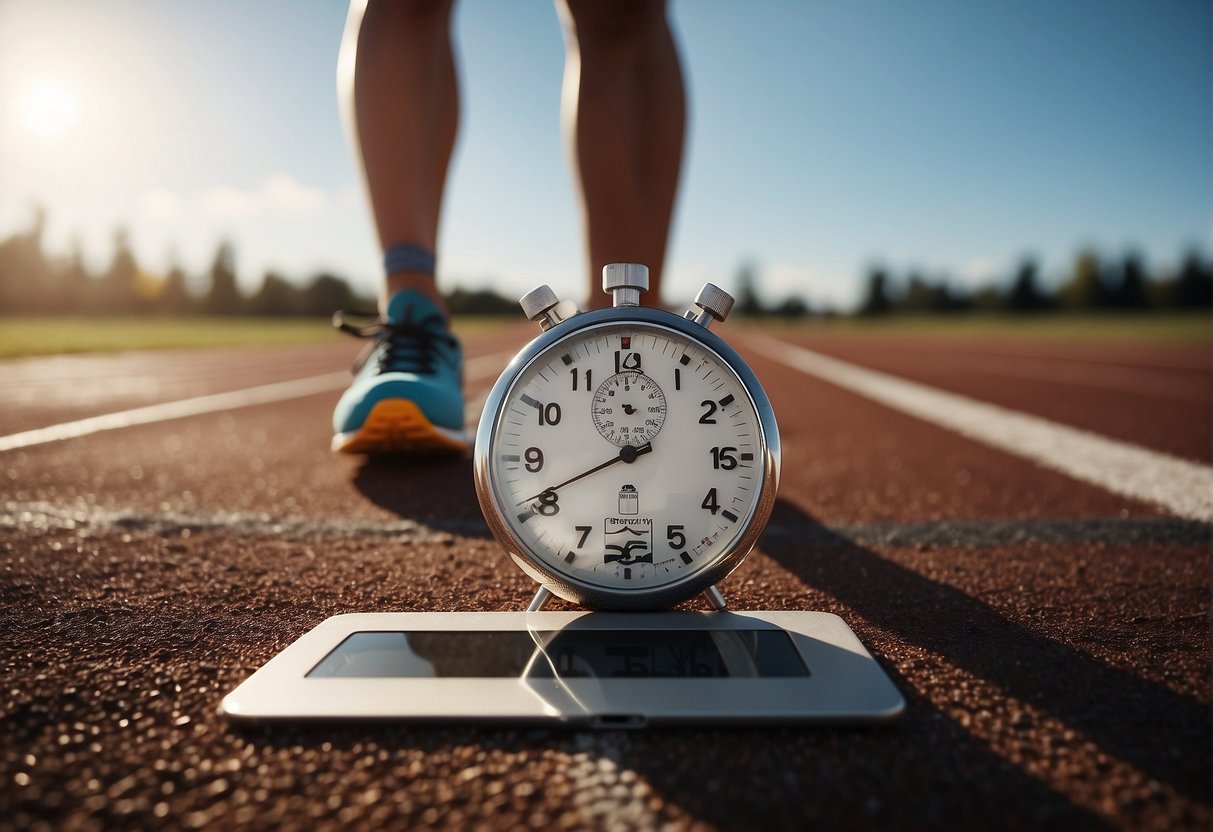
A 21 minute 5K Training Plan involves more than just running; it’s a multifaceted approach combining different workouts with strategic rest days. It’s important to incorporate intervals, long runs, and tempo runs into your regimen, allowing your body ample time to recover. Balancing hard training with proper rest reduces the risk of injury and burnout, ensuring you’re ready to perform on race day. Additionally, fine-tuning your nutrition and hydration strategy will give you the energy to maintain a strong pace throughout the race.
Key Takeaways
- To achieve a 21-minute 5K, a disciplined training plan, including various workouts, is essential.
- Recovery is as important as training, with rest days crucial in avoiding injury.
- Effective nutrition and hydration are pivotal in fueling your body for training and race day.
Quick Navigation
Setting Your 21 minute 5K Training Plan Goals

To achieve a sub-21-minute 5k, evaluating your current running level, setting an achievable time goal, and cultivating robust mental strength are essential.
Understanding Your Current Running Level
Your journey to a faster 5k starts with assessing your current fitness level and average pace. This initial evaluation will help you identify the work needed to reach the coveted 21-minute mark. Determine your personal bests and compare them with your goal pace to understand the gap you must bridge.
Establishing a Realistic Time Goal
Setting a realistic time goal is about balancing ambition with the achievable. If your average time is above the 25-minute mark, aiming directly for a 21-minute 5k might be too large a leap. Instead, set a goal time that nudges your personal best closer to the 21-minute target incrementally.
The Importance of Mental Strength in Running
Mental strength is the key to running, especially on race day. Your training should include strategies to enhance mental resilience, teaching you to push through the discomfort of chasing a challenging time goal. Hard work pays off in physical preparedness and the mental fortitude required to maintain your goal pace during the race.
Planning Your Training

Creating a successful 21-minute 5K training plan hinges on meticulous planning and integrating workouts tailored to enhancing your speed and endurance. Below are focused strategies to structure your training effectively.
Developing a Set 21 Minute 5K Training Plan
To start, establish a training plan that fits your lifestyle while offering sufficient intensity to meet the 21-minute goal. There are training runs of varying intensity spread throughout the week, ensuring a balanced approach that reduces the risk of injury. A typical plan could look like this:
- Monday: Rest or easy running
- Tuesday: Interval workouts
- Wednesday: Active recovery
- Thursday: Tempo run
- Friday: Rest or easy running
- Saturday: Long run
- Sunday: Steady run
Incorporating Different Types of Runs
Your plan must include long runs to build endurance; tempo runs to increase your anaerobic threshold, and interval workouts to improve speed. Easy runs are equally important, providing you time to recover. Each type of run serves a specific purpose, combining to form a comprehensive regimen.
Adjusting Workouts for Advanced Runners
If you’re an advanced runner, you may benefit from different approaches, such as tweaking standard workouts to be more challenging or adding more miles to your long runs. Adjusting your pace to run the race’s second half faster than the first can also train you to finish strong.
Tracking Progress with Time Splits
Monitoring your time splits is crucial to evaluating improvement. Consistently tracking times allows you to see patterns and punctuate workouts with faster-paced running. Use a stopwatch or GPS watch to record each training segment, comparing it against previous sessions to gauge progress.
Preparation for Race Day
In the final days leading up to race day, taper your training and focus on recovery. Plan your race strategy, visualizing how you’ll tackle the course and maintain the pace to cross the finish line within your target race times. Mental preparation is as important as physical tapering for peak performance.
Training Techniques for Your 21 Minute 5k Training Plan

To succeed in running a 21-minute 5K, your training plan needs to incorporate specific workouts that target different aspects of your running abilities. These techniques will help build your aerobic capacity, increase lactate threshold, and improve overall running efficiency.
Interval and Fartlek Workouts
Interval workouts are structured periods of high-intensity running followed by rest or low-intensity running. These sessions are crucial for improving your speed and aerobic power. For example, you might run 400 meters at a pace faster than your goal 5K speed, then jog for a recovery period, repeating this cycle several times. Fartlek workouts, a Swedish term meaning “speed play,” mix steady running with bursts of speed, which is less structured and can be adapted to how you feel on the run.
Tempo and Threshold Runs
Your lactate threshold is when your body switches from aerobic to anaerobic metabolism, causing fatigue to accumulate more quickly. Tempo runs or threshold runs involve running at a sustained effort near this threshold. Typically, for a 21-minute 5K runner, the threshold run pace would be slightly slower than 5K race pace, held for 20-25 minutes. This teaches your body to process lactic acid more efficiently.
Long Runs at Conversational Pace
Long runs increase your endurance, allowing you to maintain a strong pace come race day. Aim to run these at a “conversational pace,” meaning you can speak in full sentences without gasping for breath. This indicates that you’re running in the aerobic zone, which enhances your ability to use oxygen for energy over extended periods.
Speed Work with Hill Sprints
Hill sprints are a form of speed workout that builds strength and power in your legs, comparable to strength training for runners. Try incorporating short, intense uphill runs followed by a recovery walk or jog back down. These are effective in short bursts, such as 10 to 20 seconds per sprint, ensuring you give maximum effort each time.
Cross-Training for Overall Fitness
To complement your running, include cross-training exercises like swimming, cycling, or rowing. These low-impact exercises help to improve your cardiovascular fitness without the added stress on your joints. Also, adding core work and strength training can help prevent injuries and improve your running posture and power.
21 Minute 5k Training Plan and Rest and Recovery

Achieving a 21-minute 5K demands consistent training, strategic rest, and recovery. This balance is crucial to avoid injury and improve performance.
21 Minute 5k Training Plan and Scheduled Rest Days
Rest days are a critical component of your training plan. You should schedule at least one or two weekly rest days to allow your muscles to repair and strengthen. Mark these days on your calendar as non-negotiable, ensuring you give your body the necessary downtime.
- Monday: Rest
- Tuesday: Interval Training
- Wednesday: Easy Run
- Thursday: Tempo Run
- Friday: Rest or Cross-Training
- Saturday: Long Run
- Sunday: Active Recovery
Active Recovery Techniques
During active recovery, you’re not sitting still; think of it as a low-intensity exercise to stimulate blood flow and facilitate muscle repair. Methods like walking, swimming, yoga, or cycling for no more than 30 minutes can be effective. Ensure these activities are performed at a low intensity to aid recovery truly.
- Yoga: Focus on gentle stretches to improve flexibility.
- Cycling: A leisurely bike ride can keep muscles engaged without excessive strain.
The Role of Sleep in Recovery
Sleep is paramount for recovery and performance. Aim for 7 to 9 hours of quality sleep each night to help your body heal from the day’s workout and prepare for the next. Ensure your sleep environment contributes to restful sleep.
- Optimal Sleep Environment:
- Room Temperature: Around 65°F (18°C)
- Darkness: Use blackout curtains or a sleep mask.
- Quiet: Consider earplugs or a white noise machine if necessary.
Nutrition and Hydration Strategies for your 21 Minute 5k Training Plan

Proper nutrition and hydration are crucial components for preparing for a 5K, especially if you aim to complete it in 21 minutes. Your performance during training runs and on race day is directly influenced by how well you fuel and hydrate your body.
Fueling for Training Runs
When preparing your 21 minute 5K training plan, your training runs are the backbone of your success. For these efforts, timing your meals is essential. Consume a balanced meal with carbohydrates, protein, and fats 2-3 hours before your run. If you’re pressed for time, a small, carb-rich snack 30 minutes prior can help, such as a banana with a drizzle of honey. Focusing on complex carbohydrates like whole grains is important on longer runs, as they provide sustained energy.
Hydration for Endurance Running
Hydration should not be overlooked, particularly during long runs where your body loses fluids through sweat. Start hydrating well before your run, aiming to drink small, frequent sips of water. Consider an electrolyte replacement drink on runs longer than an hour to replenish lost salts. On race day, begin hydrating early in the morning, but avoid large quantities right before the start to prevent discomfort.
Recovery Nutrition Post-Run
After you finish a run, your body’s priority is recovery. Within 30 minutes, consume a mix of protein and carbohydrates to repair muscles and replenish energy stores. An example could be a glass of chocolate milk or a yogurt with fruit. The recovery meal ensures you bounce back stronger for your next training session.
Remember, training for a 21-minute 5K isn’t just about the miles you log; it’s also about giving your body the right fuel and hydration to perform optimally.
21 Minute 5k Training Pland and Race Day Preparation

Completing a 5K in or around 21 minutes requires rigorous training and a solid plan for race day. Your preparations should include a strategic approach to the race, effective warm-up and cool-down routines, and a tactical method for handling the more challenging second half of the race.
Planning Your Race Strategy
Your race strategy should begin with establishing a target race pace that’s both challenging and achievable, ideally based on your prior race times during training. Aim to start with a conservative strategy to conserve energy, setting the stage for more aggressive results later. Position yourself well at the start to avoid early bottlenecks, with a clear mental image of crossing the finish line within your goal time.
Warm Up and Cool Down Routines
A comprehensive warm-up before the race enhances your performance and reduces the risk of injury. Plan a routine with dynamic stretching and a brief, steady run to elevate your heart rate. After your warm-up, maintain a light jog or walk to keep your muscles active until the race begins. Post-race, your cool-down should include light jogging and static stretches to facilitate recovery. Remember, a proper warm-up and cool-down can make the difference between a good and a great race time.
Navigating the Second Half of the Race
Your earlier conservative strategy pays dividends in the second half of the race. Now’s the time to assess your energy levels and decide if you can increase your pace. Continually monitor how you feel and gradually increase your speed towards a strong finish if possible. Your focus should be on consistent effort, even when fatigue sets in. In this phase, races are often won or lost; stay focused on your race day strategy to maintain a steady rhythm and finish strong.
Benchmarking and Improvements and Future 21 Minute 5k Training Plan

When you aim to complete a 5k in 21 minutes or less, assessing your progress and refining your training plan is crucial. This involves a detailed analysis of your race times and training data, setting new goals upon reaching milestones, and making informed adjustments to your training based on feedback.
Analyzing Race Times and Training Data
To become one of the best runners in your category, you must scrutinize both race times and training runs. Record your faster paces and compare them against different distances to identify patterns. Tools and apps endorsed by experts like JM Coaching can track your performance, offer insights into your strengths and weaknesses, and suggest areas requiring active recovery.
Setting New Goals After Achievements
After achieving a personal best, setting new, challenging goals is essential. These objectives should spur your motivation, whether increasing your speed, enhancing endurance, or even participating in more competitive races. Always ensure your new goals are realistic, measurable, and framed by your personal experience and best runners’ standards.
Using Feedback for Training Adjustments
Feedback is an invaluable component of training, potentially coming from your own observations or from coaching influences. Analyze this feedback to make precise adjustments to your training program, like modifying intensity or incorporating specific workouts for speed or stamina. Effective feedback application helps prevent plateaus and steers your training in the direction of continuous improvement.
Additional Resources and Advice for Your 21 Minute 5K Training Plan

As you embark on a training plan to achieve a 21-minute 5K, it’s crucial to supplement your physical training with additional resources and advice. Quality reading materials, engaging with running communities, expert coaching, and advanced technology can offer the comprehensive support you need to hit your goal.
Recommended Reading and Running Communities
For other helpful guides on a 21 minute 5k Training Plan, Runner’s World offers extensive articles detailing training tips and schedules for various levels. Their insights can be the best thing to refine your training techniques. To connect with others for further information and support, consider joining online forums or local running clubs, such as the JM Run Club, where you can share experiences and advice with fellow runners.
Expert Coaching Services
Expert coaching services can be invaluable if you’re looking for personalized guidance. A current lead coach like Jonny Mellor of JM Coaching can provide tailored training plans and feedback. They build on the knowledge from previous personal coaches and adapt strategies to suit your needs, offering real-time advice and adjustments to your training regimen.
Leveraging Technology for Training Insights
In today’s age, technology plays a pivotal role in training. Apps and devices can provide insights into your performance in real-time, and platforms like Run Coach offer structured training plans along with adaptive guidance to help improve your running efficiency and speed. Wearable tech can also help track your progress and provide data essential for refining your workouts and recovery.
Conclusion 21 Minute 5k Training Plan
Embarking on a 21 minute 5K training plan is a comprehensive journey that requires dedication, strategic planning, and a holistic approach to training and recovery. This plan prepares you physically with a mix of interval, tempo, and long runs and emphasizes the importance of rest, nutrition, and mental strength. Runners can significantly improve their performance by meticulously following a structured training regimen, leveraging expert advice, and utilizing technology for insights.
Achieving a sub-21-minute 5K is not just about crossing the finish line faster; it’s about setting a challenging goal, pushing your limits, and realizing your full potential as a runner. Completing a 5K in 21 minutes or less is within reach with the right plan, support, and determination, marking a significant achievement in any runner’s journey.

